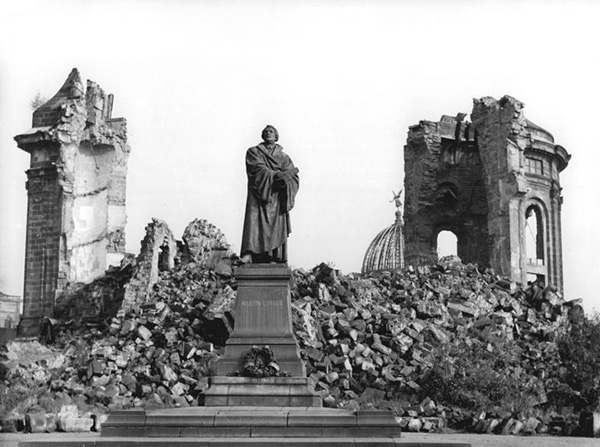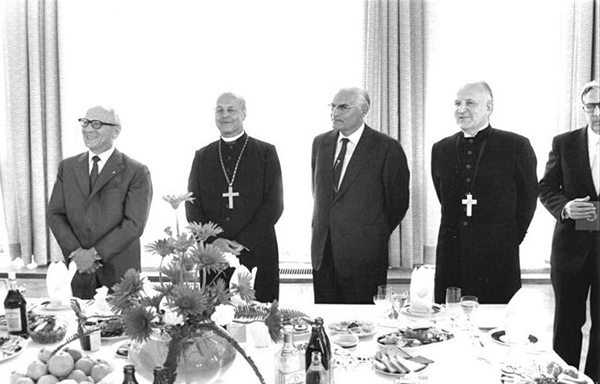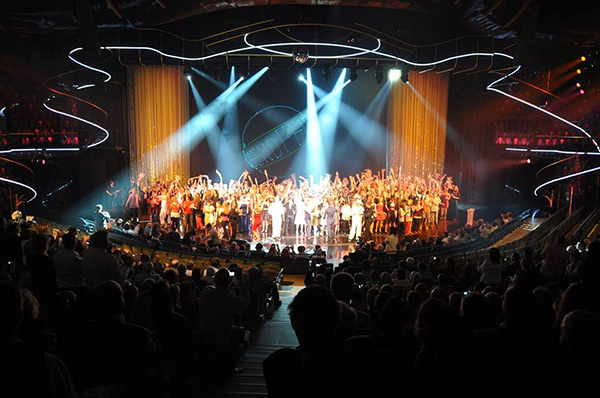Subtotal: $
Checkout
Why We’re Still Atheists
Thirty-five years after the Berlin Wall fell, few places are as secular as the former East Germany. A German asks why.
By Katja Hoyer
November 8, 2024
Available languages: Español
Eastern Germany is sometimes referred to as “the most godless place on earth.” In 2012 such headlines went around the world when the University of Chicago published a global study comparing beliefs about God across time and space, and eastern Germany topped the tables on atheism. Nearly 60 percent of people from eastern Germany said that they didn’t believe in God and never had. In the rest of Germany, fewer than one in ten people said the same, and in the United States fewer than one in twenty share this view.
The question of what caused this unique cultural environment in which there is not just a decline of institutional religion, which we also observe elsewhere in the Western world, but a widespread absence of faith altogether is well worth asking.
Many studies have indicated that there is a correlation between faith and education. Globally, atheists have undergone more years of schooling than the average population. This would imply that to stop believe in God involves some form of intellectual choice.

The rebuilt Martin Luther monument and the ruins of the Frauenkirche, Dresden, which the GDR left ruined as a war memorial. Photograph by Giso Löwe / Creative Commons, November 1958.
Outright atheists, as opposed to those not belonging to a religious community, are still a minority across the world. Even in China, which is officially atheist and by many standards a secular society, the 2018 World Values Survey found that only a third of people identify as atheists. So pure nonbelievers are conscious intellectual minorities around the world – except in eastern Germany.
According to the University of Chicago study, eastern Germany is the only part of the world where not believing in God is a majority view, the norm with which people grow up. For most people there, it would take a conscious intellectual effort to become religious.
Take me as an example. Born in 1985, I belong to the last “Generation East,” born in the GDR but too young to really remember it. Yet its policies still shaped me and my generation. As a teenager, I took part in a student exchange program to Israel, where our group met with Jewish and Muslim peers, an encounter intended to increase empathy. But difficulties began right away when our delegation – all born in East Germany – couldn’t engage in questions on religion.
“I don’t pray,” I said to my Muslim and Jewish counterparts. “What do you mean?” they both asked, astonished. “I don’t pray. I’m not religious,” I answered. Staring into their blank faces, it slowly began to dawn on me that the program organizers hadn’t considered that the supposedly Christian delegation to this multifaith exchange wasn’t Christian at all. Whoever came up with the idea evidently had no concept of the total absence of religion in our lives. I wasn’t even able to explain theoretically what it meant to be Christian because I had no real concept of it beyond the extremely secularized calendar events like Christmas and Easter that still punctuated the year for us.
This embarrassing encounter impressed on me for the first time that the way I had grown up wasn’t “normal.” My whole worldview was clearly unusual. Other people prayed to God for guidance and support. I knew I was on my own. Believers shared the notion that there is some form of life after death rewarding the good and punishing the bad, which gives meaning to their lives here and now. I, on the other hand, often wondered even as a child what the point of life was if all you did is grow up, work, die, and be erased. When I lost relatives, friends, and pets, I knew I had lost them forever, while others held out for some form of reunion in another life or at least the idea that souls continued to exist somewhere.
I had grown up in a world that made sense without God and nothing could change that now.
On an abstract level, I began to understand why most of humanity finds comfort, surety, and purpose in religion. But by the time I worked this out, it was entirely an intellectual mind game to me. I had grown up in a world that made sense without God and nothing could change that now.
I realize how desolate an atheist existence must sound to Christians. Many have since tried to convince me to give religion a chance to permeate my life. At a Catholic wedding I attended a few years ago, for instance, the priest noted that I stayed seated throughout mass, refraining – respectfully – from kneeling, singing, and praying. He made a point of sitting next to me at tea afterward, telling me that atheism is no way to lead a life. As I pleadingly looked around the room for someone to rescue me from this awkward position, I wondered what the priest thought the point of this conversation was. Did he really think he could change my entire outlook over a slice of Black Forest cake? I appreciated that he was concerned about my soul, but I could no more will myself to believe in God than he could stop believing in him.
Today, thirty-five years after the fall of the Berlin Wall, people in eastern Germany continue to live in a uniquely atheist cultural environment. People are often surprised by the fact that former East Germans didn’t flock back to the churches after the collapse of the system that purged religiosity from most of their lives. From the vantage point of the intrinsically Christian societies of the West, the aggressively atheist policies of the GDR dictatorship seemed to suppress rather than erase religious beliefs and practices during the Cold War. Cultural Christianity seemed so obviously to be an intrinsic part of life in Europe that many expected it to bounce back in the East when the regime and its policies vanished in 1990. But that never happened.
After the Second World War, the Soviet Zone of Occupation that would later become the GDR contained an estimated 82 percent Protestants and 12 percent Catholics, meaning almost everyone belonged to a Christian community. In 2022, these figures stood at under 15 percent and 5 percent respectively.
This sharp drop over just a few generations cannot simply be attributed to socialism. Of the other former Soviet satellite states, only the Czech Republic’s levels of nonbelievers came close to East Germans in the Chicago study, with 40 percent saying they don’t believe in God. But countries like Poland (3 percent), Slovakia (12 percent) and Hungary (15 percent) show that religion usually held out against socialist erosion – not least in Russia itself where only 7 percent said that they didn’t believe in God and never had.

Erich Honecker with church representatives at the meeting of the Martin Luther Committee, June 13, 1980. Photograph by Schneider / Creative Commons.
East Germany was strikingly different from other socialist states in that there was less inner and outer resistance to the atheist policies during the Cold War from the general population compared to other eastern European nations, where religion often became a rallying point.
To explain this divergence, it makes sense to look at the experiences unique to East Germans. The most obvious difference to the other nations that ended up under Soviet influence is that they were Germans. They had lived under Nazi rule, where the erosion of Christianity had already made inroads. Seeking absolute moral authority over its subjects, Adolf Hitler’s regime had incorporated Christian youth organizations into its own Hitler Youth, pushed for a unification of Protestants in a state-controlled Reich Church (Reichskirche), and struck a concordat with the Catholic Church.
Despite notable resistance to Nazism from both denominations, there was also much compliance and tacit acceptance of the gradual encroachment of Nazi ideology into spheres traditionally reserved for religion. Swastikas appeared in churches. Hitler’s book Mein Kampf was given to newlyweds. Boys and girls learned to value strength above charity.
The German public was also deeply disturbed by the experience of war, defeat, and conquest. The latter applies especially in the east, where the Red Army engaged in widespread looting and violence, including rape. Historians estimate that around two million women were raped by Soviet soldiers – something the vast majority never spoke about. Add to this trauma the collective sense of guilt and shame when horrific details of the war and Holocaust became known, and a picture of a morally disorientated and disillusioned people emerges.
Once the GDR was set up, its policies continued to undermine the weakened foundations of Christianity in eastern Germany. Its measures toward the churches varied in intensity and methods over the years but were ultimately aimed at a phasing out of religion. Like the Soviet Union, East Germany followed Karl Marx’s doctrine that religion was “the opium of the masses,” effectively a means to keep people in their allocated place in society and endure exploitation in exchange for salvation in the afterlife. But the regime was also keenly aware that it had inherited a society deeply rooted in Christian traditions and tired of conflict. So, an attempt to abolish the Protestant and Catholic churches outright was deemed too abrasive. The plan was rather to bind them into the state structures where they could be observed, controlled, and hollowed out over time.
The GDR focused on raising young people in a world without God, rather than taking on the churches directly.
Western criticism of anti-Christian policy in the GDR has often focused on the tangible repression or the outright destruction of religion. Throughout the four decades of the state’s existence, around sixty churches were demolished. Some were war damaged, but not all. Many church representatives critical of the state were arrested, such as the ordained Lutheran pastor Georg-Siegfried Schmutzler, who was taken into custody on April 5, 1957, and given a five-year prison sentence (from which he was released early in 1961 following an intense backlash). Cases of aggressive repression like this are often what people associate with the GDR’s state atheism.
More important for the long-term development of religion in East Germany, however, were policies that distanced young people from the churches in less obvious ways. Here, too, the GDR initially applied a heavy-handed approach by targeting church youth organizations like the Junge Gemeinde, which had close links to West German counterparts. In 1952, Erich Honecker, who would become East Germany’s leader in 1971 but was responsible for youth development in the 1950s, called the Junge Gemeinde a “cover organization for warmongers, sabotage, and espionage on behalf of the Americans,” and around three hundred members were expelled from their schools.
Due to the popular uprising of June 17, 1953, during which the Red Army was called in to save the East German regime from its own people, leaders had to row back on the more aggressive measures. The Soviets demanded a softer course on all fronts to stabilize social structures. While periods of reconciliation and repression continued to ebb and flow, the GDR focused on raising young people in a world without God, rather than taking on the churches directly.
This began before the GDR was even established as a state. In 1946, the Free German Youth was formed in the Soviet Zone of Occupation as a centralized organization for young people. Honecker, who oversaw this process, won over the Catholic cathedral vicar Robert Lange and the Protestant youth pastor Oswald Hanisch for this project, which provided a secular environment for young people between fourteen and twenty-five from all backgrounds. The vast majority joined.
The job of secularizing East German children was made much easier because women were encouraged to work. By the late 1980s, over 90 percent of women worked, the highest rate of female employment in the world. By comparison, in West Germany, only half of women worked, the majority part-time. Accordingly, East German children spent much more time in state-run childcare, away from domestic and community structures that may have provided religious settings.
The Christian events that punctuated people’s lives were also secularized. The most striking example is the introduction in 1954 of Jugendweihe (literally, youth consecration), a coming-of-age ceremony directly intended as a replacement for confirmation. It worked through a mixture of pressure – not taking part in Jugendweihe could have severe consequences for the teenagers’ educational and professional prospects – and genuine enthusiasm for a ceremony many young people enjoyed since it involved gifts, family celebrations, and being taken seriously as a full member of society. By 1959, 80 percent of each cohort participated in the new ritual, eventually, numbers would rise to above 90 percent.

Jugendweihe, Berlin 2011. Photograph by Thomas Hummitzsch / Creative Commons.
The churches reacted in different ways. Initially both Protestants and Catholics pushed back against Jugendweihe by denying those who chose to participate in the state ritual the church one. But faced with increasing Jugendweihe acceptance in the population, the Protestant Landeskirchen – regional church bodies – relented and allowed their members to attend both ceremonies.
This policy is an example of the desire of many within the church communities to find a way to build a future for Christianity within the East German system. In the 1970s, Bishop Albrecht Schönherr, chairman of the Federation of Protestant Churches of the GDR, which had been founded in 1969, announced: “We want to be church not alongside, not against, but within socialism.” The idea was that churches would tone down their antagonism toward the state and in turn maintain more autonomy from state interference and repression.
Among the better-known representatives of this accommodating stance is Horst Kasner, a priest Schönherr helped install in the town of Templin, around forty miles north of Berlin. Kasner had moved to the GDR from Hamburg in July, 1954, bringing his wife Herlind and baby daughter Angela with him. As a teenager, Angela didn’t participate in Jugendweihe, but she joined the Free German Youth and stayed in it until the age of thirty – much longer than usual. As a religious leader, her father didn’t oppose state socialism and was even nicknamed “Red Kasner” by some. As a result, Angela faced no obstacles to her desire to study physics at Karl Marx University Leipzig. She would later go on to become reunified Germany’s chancellor as Angela Merkel.
Despite such periods of mutual tolerance, the conflict between church and state flared up again when the Lutheran pastor Oskar Brüsewitz took his own life in 1976 in a public act of self-immolation in the town of Zeitz. Brüsewitz had been a vocal and eccentric critic of the state to the point where the regional church leadership had asked for him to be moved to another rectorate. But following Brüsewitz’s suicide the regime’s defamation of the man as “abnormal and sick” caused a severe backlash from the church community.
The conflict was eventually resolved when Erich Honecker met a delegation of Protestant leaders in 1978 and thrashed out a workable compromise. The churches would be better shielded from state interference and allowed to maintain institutions in social and medical care. But crucially, education remained the exclusive reserve of the state. This compromise led to the stabilizing of the churches as institutions in East Germany but further eroded their influence over young people, since key rituals, schooling, and youth activism remained state-led.
When Christianity acquires a form that becomes harder to distinguish from secular structures, it begins to compete with them, and it doesn’t always win.
That is not to say that there wasn’t church-led resistance to the dictatorship in which young people engaged in large numbers. The role the churches played in organizing and shielding dissent is well documented. From the 1960s on, the churches led the pushback against the regime’s increasing militarization of society. The peace movement Swords to Ploughshares was closely connected to the Protestant churches, which helped organize demonstrations and other activism effectively, including with their counterparts in West Germany. Church days, discussion forums, and Swords to Ploughshares services often attracted thousands of participants throughout the 1980s.
Churches supported other forms of dissent in the 1980s, particularly the environmental movement. In 1986, the Umwelt-Bibliothek or “Environment Library” was set up in the Zionskirche in Berlin. This church had been in the parish of Dietrich Bonhoeffer, who had organized resistance against the Nazis – a powerfully emotive backdrop to the activists who now erected homemade shelves in its basement, where banned books and magazines were stored. A Stasi raid on the facilities in 1987 backfired spectacularly as people rallied around the community in peaceful protest. Other opponents of the regime took courage from this and flocked to churches, thus forming a bedrock for the Peaceful Revolution of 1989.
But the fact that churches were full in the late 1980s was more a sign of people’s need to organize and form communities from which they could bring about the change they desired than a turnaround from the religious erosion that was now inexorably moving toward mainstream atheism. After the Second World War, nearly everyone had been a church member. By 1989 only a quarter of the East German population was, and no amount of political activism would change that. The trend has continued without political pressure for the last thirty-five years, showing that it’s important not to conflate the story of church representatives in the GDR with that of mainstream religiosity.
People have tried to find any number of historical explanations for eastern Germany’s religious Sonderweg (special path) that go further back in time. One theory holds that in contrast to West Germany, which by historical coincidence ended up with most of the Catholic regions, the Lutheran brand of Protestantism most East Germans had subscribed to values individualism over institutional structures and is thereby more susceptible to cultural change.
There is also an argument that the attempts of many Protestant communities to align their existence with the secular state policies of Nazism, socialism, and modern democracy – as different as they may have been – had a corrosive effect in itself. As far as I can tell from my atheist viewpoint, much of the appeal of religion stems from its ability to offer a physical and spiritual world that provides sanctuary from the grind of everyday life. Churches are beautiful buildings with an atmosphere no living room or office can hope to match. Religious leaders guide with a moral clarity no elected politician can muster. When Christianity acquires a form that becomes harder to distinguish from secular structures, it begins to compete with them, and it doesn’t always win.
Take the GDR’s offering of alternatives to religious institutions. Not unlike the Hitler Youth before it, the Free German Youth was deeply politicized but not unattractive to young people. It allowed them to organize travel, cultural events, and youth activities that could be fulfilling – as Angela Merkel’s extended membership shows. She traveled to Poland in 1980 and 1981 through the organization’s travel agency and organized events through her group in Berlin.
Nonreligious institutions and rituals became normalized over time. Many years after the fall of the Berlin Wall, nobody forced me to have my Jugendweihe. I was looking forward to the occasion, the family celebrations, the gifts, and the recognition as a young adult. I had a handful of friends who had a confirmation ceremony instead and as far as I could see, they had nothing I didn’t have. Decades of assimilation and erosion in eastern Germany have left the churches bereft of qualities that had once made them special to the masses.
There is no way around the conclusion that the aggressive state atheism of the GDR found fertile historical and cultural ground on which to speed up a process that is also visible elsewhere in secularized societies. It’s a phenomenon worth studying in detail, as what happened in Eastern Germany might offer a glimpse into a future that could await other Western societies.
Already a subscriber? Sign in
Try 3 months of unlimited access. Start your FREE TRIAL today. Cancel anytime.







Michael Nacrelli
Hoyer writes: "I, on the other hand, often wondered even as a child what the point of life was if all you did is grow up, work, die, and be erased... I realize how desolate an atheist existence must sound to Christians." My question is: "How does any atheist NOT find life desolate and meaningless?"
Mimi
A very well written article. My life couldn’t have been more different. I came to know Jesus in a personal way whilst a child, waited for my faith to become diluted in my late teen and twenties . Instead my relationship with Christ began slowly to mature as I recognised my need of Him in my life. Christ knows loves me and knows me to my core. My struggles are human and will always be but I have someone who loves me no matter what and that conviction helps me through life.
Agarimos Ledos
It's funny the comparison between the really well written article by the atheist author and the fanatical and extremely-biased comments from Nigel and Paul. That's what drives sensible people away from the religious lies: the evidence that many believers and their leaders are just nutjobs. More atheism and agnosticism are necessary to build better societies.
Nigel Parrott
I am working for ourLord in Eastern Estonia. It is a very similar situation here the nation is almost Atheist. However the Church here in the Russian speaking area is growing,so much so we are looking to enlarge our building from seating 30 to being able to accommodate 80. Our Lord is alive and well !🙏 The younger people have a desire for the spiritual. it is our calling to fill that with Spirit filled young people. Rather than allowing them to seek the pagan .
Paul Brandenburg
Thank you, Katja, for your sobering caution about the dangers of accommodating secularization. Your article reminds me of an experience I had in 2017 while hiking the Ecumenical Pilgrim Way east of Leipzig, a newly restored segment of the Camino de Santiago. It was the 500th anniversary of Luther's Reformation and I, an American Catholic, was curious to see how Christian unity was being expressed on the Pilgrim Way. I spent an afternoon hiking alongside Maria, a nurse from Leipzig, who I was dumbfounded to learn, knew NOTHING of Christianity. She was politely curious about all I had to say. Yet, though her life seemed drab, without direction and hope--even to her--she wasn't genuinely intrigued by Jesus and hungry to learn more. Instead, the Gospel was so foreign it sounded like a fairy tale to her, an entertaining story. How I wish we'd had more than an afternoon together! As your piece shows, Katja, we who would be a remnant of faithfulness in an increasingly pagan world have much work to do. Lord have mercy on the people!
Miguel Delagos
Fascinating article and well written. The experience of East Germany and the author's take on atheism underscores the contingent social forces at work in the secularized world. She presents her own atheism and her view on religion in a balanced, respectful way I appreciate and can learn from. Thank you!